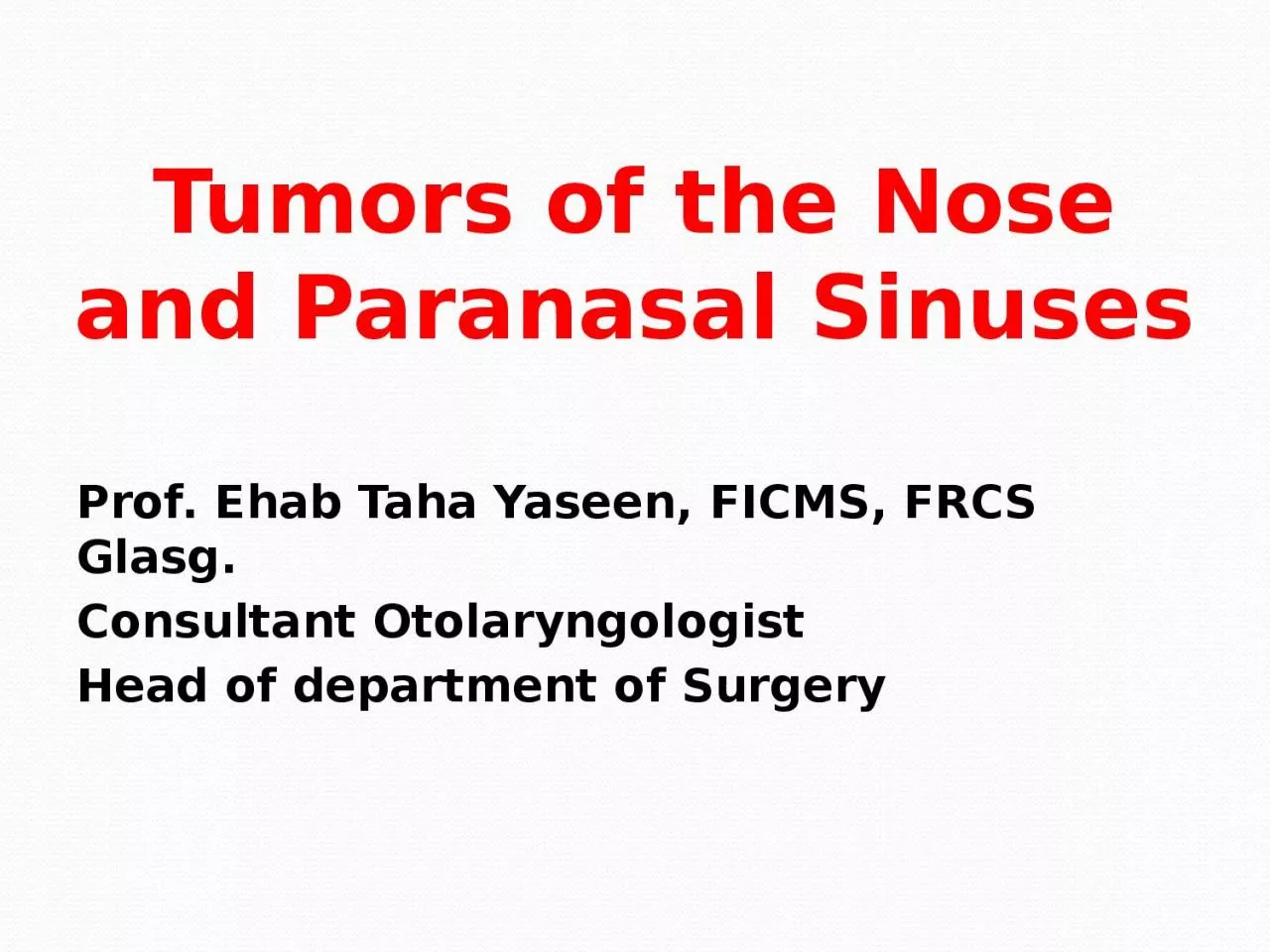

Prof Ehab Taha Yaseen FICMS FRCS Glasg Consultant Otolaryngologist Head of department of Surgery Benign tumors They are divided into A Epithelial tumors 1Papilloma 2 types ID: 1010644
Download Presentation The PPT/PDF document "Tumors of the Nose and Paranasal Sinuses" is the property of its rightful owner. Permission is granted to download and print the materials on this web site for personal, non-commercial use only, and to display it on your personal computer provided you do not modify the materials and that you retain all copyright notices contained in the materials. By downloading content from our website, you accept the terms of this agreement.
1. Tumors of the Nose and Paranasal SinusesProf. Ehab Taha Yaseen, FICMS, FRCS Glasg.Consultant OtolaryngologistHead of department of Surgery
2. Benign tumors:They are divided into:A) Epithelial tumors1-Papilloma: 2 types a- WartIn the nasal vestibule: (note: the vestibule is lined by skin) As sessile or pedunculated mass HPV Found accidentally or by the patient Treated by surgical excision or by laser treatment. Recurrence especially in adult should be treated with care.
3. b- Inverted papilloma (Ringert's tumor, transitional cell tumor) Pathology: gross thickening of the epithelial surface leads to in-folding but the basement membrane remain intact. found in the nasal fossae and sinuses Commonly arise from the lateral wall of the nose followed by maxillary then ethmoid sinuses. Recurrence after excision suggests malignancy. Some times malignancy coexists with this papilloma.
4.
5.
6. 2- Adenoma Arise from the glandular tissues, May become malignant.
7. B) Connective tissue tumor:1- Fibroma: from the turbinate and septum2- Osteoma: 2 types a) Compact osteoma most commonly found in the frontal sinus in adult, Ivory hard in consistency. May be silent or found accidentally on X-ray,
8. May expand the sinus Displace the eye Obstruct the frontonasal duct causing mucocele or empyema Press on the posterior table of the frontal sinus causing headache, CSF rhinorrhea and intracranial infection. b) Cancellous osteoma more common in the maxillary and ethmoid.
9.
10. 3- Angioma 3 types a) Capillary commonly from the septum Bleeding polyp of the septum Usually mixed with fibrous tissue. Present with bleeding. Treated by simple excision and cautery. b) Cavernous involving the tip of the nose
11. c) Multiple telangiectases - Osler's disease- Usually present with recurrent bleedings.4- Chondroma: arise from cartilage, rare.
12.
13. 5- Angiofibroma Adolescent males.Benign fibrovascular tumors with characteristic irregularly-shaped vessels, which may be lined by endothelial cells onlyUsually arises from the lateral wall of the posterior nasal cavity close to the sphenopalatine foramenUsual features are nasal obstruction and profuse nasal bleeding
14. Histopathologically is classified as a benign lesion, however, bony erosions of the pterygoid, the clivus and the sphenoid sinus floor are characteristicsMay show both orbital and cranial extensions
15. Treatment of all Benign Tumors All benign tumors are treated by excisionEndoscopic approach is a favorable treatment option for the management of benign tumors
16. Malignant Tumors: - Represent 1% of all neoplasms.- 5 year survival rate of 40%. - Male predominance.
17. There are associated factors with these tumors:1- Aflatoxin (dust, foods)2- Chemical agents and heavy metal exposure (Cr, Ni, hydrocarbons3- Wood dust associated with ethmoid tumors4- Tobacco smoke5- Smoked food6- HPV
18. They are divided into:A) Epithelial tumor: Carcinoma --Squamous cell carcinoma is the commonest tumor of the nose and paranasal sinuses account for 80% of malignant tumors of the nose and sinuses. The commonest site is the maxillary sinus followed by the nose.--Adenocarcinoma --Adenoid cystic carcinoma
19. B) Connective tissue tumors--Sarcoma (fibrosarcoma, osteosarcoma)--Melanoma--LymphomaC) Metastasis from other primary sites:Rare, but may comes from the breast, thyroid and prostate.
20. Concerning Clinical FeaturesReason for concernClinical Featuresmass effect.Nasal obstructiontumor necrosisEpistaxisnecroses and infectionDischarge which may be bloody stained with bad odourInvasion by the tumorSwelling of the cheek, alveolar margin and nasal bridge.Invasion of the alveolar process and dental rootsLoose teeth, ill fitting denture, dental paraesthesiainvasion of the orbitProptosis . The direction of proptosis will be according to the site of the tumor e.g. maxillary sinus tumor will bush the eye superiorly. Invasion by the tumorUlceration of the palate, cheek
21. Concerning Clinical FeaturesReason for concernClinical Featurestumors of the ethmoid sinuses.Hypertelerosim which means increased distance between the medial canthi of the eyes by tumor expansion, normally the distance is not more than 4 cm in adult. Compression/invasion of the maxillary or infraorbital nerve, more in adenoid cystic carcinomaFacial paraesthesiainfection, periosteal involvement or dural involvementPain and headacheobstruction of the nasolacrimal ductEpiphoraDue to periosteal and bone invasion other wise no lymph nodes will be seen.Palpable cervical nodal disease
22. Concerning Clinical FeaturesReason for concernClinical FeaturesObstruction/invasion of eustachian tubeConductive hearing loss/Middle ear effusionOptic nerve involvementIntra-cranial extension, optic chiasm compressionInvolvement of intra-orbital contentsVisual change/lossVisual field changeDiplopia/OphthalmoplegiaPain on eye movementChemosis/Orbital displacementDural/Intra-cranial involvement with CSF leakClear rhinorrheaPossible involvement of facial soft tissuesFacial asymmetryErosion of the nasal floor or maxillary sinus floorOronasal or Oroantral fistulaParaspinal muscle involvementReduced neck range of motion
23. Diagnosis and preoperative planningHistory and full clinical examinationEndoscopic evaluation (site, extension, possible type and planning of surgery)Radiology (characterize the tumour, assess the local and regional extension and planning of surgery and adjuvant treatment) CT scan and MRI (usually with contrast)
24. 4. Biopsy usually endoscopic guided5. FNA if there is palpable LN
25.
26.
27.
28. Radiology CT MRI + contrastScott-Brown’s Otolaryngology Head and Neck Surgery/Vol. 1/ p.1271
29. TreatmentSurgery: A) Endoscopic: findings support the endoscopic approach for the management of sinonasal tumors are:Reduced morbidityImproved vascular controlBetter quality of lifeEquivalent survival outcomes to open approaches
30. B) Classical ProcedureMaxillectomy (partial or total, medial, inferior medial)External ethmoidectomyCraniofacial fronto-ethmoidectomyExtended craniofacial resection 2. Radiotherapy3. Chemotherapy
31. Go towww.menti.com
32. Thank You